
|
Sale 36
Pre-Long Beach Coin and Currency Auction
| Lot |
Photo |
Description |
Realized |
Lot 3008 |
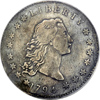 |
1794. BB-1, B-1 Very Rare. PCGS graded VF-35 .PQ. Light to medium uneven grey toning on both sides. Better than average strike. Nice full date. Very few adjustment marks which normally plaque this date. Choice for the grade. Should be resubmited for upgrade. Compared to the 1794 dollar in NCS sharpness of EF, this coin has better details.
The silver dollars of 1794 are from a single pair of dies cut by Robert Scot, hired in November 1793 as Engraver on the basis of his work on bank-note plates. The head of Liberty is a copy of his 1794 cents, but without the cap. The planchets used on these coins were made from part of the Bank of Maryland's bullion deposit of July 18, 1794: 94,532 ounces of French minor coins containing 69,692.4 ounces silver; this had to be brought up to 900 Fine. (A good portion of the bullion used to strike coins in those days came from melted foreign coins.)
Because no press heavy enough for dollars had yet been built for the Mint, these heavy, thick coins were struck on the largest one at hand -- that originally were meant for cents and half dollars. Because so many of the new dollars were poorly struck, they were at once criticized for weakness of impression: "the touches of the graver are too delicate, and there is a want of that boldness of execution which is necessary to durability and currency" said the New Hampshire Gazette of December 2, 1794. The fault, however, was less in the die than in press weakness and axial misalignment. On most survivors, obverse and reverse dies were in nonparallel planes, making the left side of the coin weaker, especially at the date and the first star on obverse and with UNITED STATES also weak on the reverse. The present coin has much better definition in these areas and is recommended for this reason. In fact, specimens with all these details clear are very rare, forming only a tiny minority. The mintage figure of 1,758 is thought to represent the acceptable remainder of (probably) 2,000 coined on Oct. 15, 1794, the remaining impressions (242?) being rejected imperfectly made, and retained in the Coiner's Vault for subsequent use as planchets according to Julian {1978}, p. 51. (There is a single example of 1795 showing traces of overstriking on one of these weak 1794 dollars, according to the Breen encyclopedia.) (PCGS # 6851) .
Estimated Value $200,000 - 240,000.
View details and enlarged photos
Check results on similar lots
| Realized
$241,500 |
Lot 3009 |
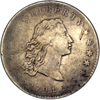 |
1794. BB-1. B-1 Very Rare. NCS graded Sharpness of EF-45 Obv Repaired. Nice clear date. 1794 initiates coinage of America's monetary "standard", the denomination whose 26.96 grams of silver equates to "One Dollar" the same as 12 standard inches equates to one foot. The mintages were small throughout 1794-1803 because little demand existed domestically for silver dollars. The first United States Mint struck coins to order, for the most part. Bankers and others deposited silver and gold with the Mint, which the Mint's workers turned into coinage and then delivered to the owners of the precious metals. In 1794 in particular, as the mint geared up for regular production, the equipment just wasn't up to the task of striking a large coin like the silver dollar. Nearly all of this year's mintage of 1,758 pieces contains areas of weak striking on both sides. Predominant in this are the left side stars which barely show on some and are completely gone on others. This specimen doe has its date numerals visible, although we note that someone long ago strengthened the 1 of the date to make it clearer, as well as some hair curls. There is a small lamination in the planchet below the Y in LIBERTY as well as other signs of tooling and repair to the right of the date. On the reverse, the rim has a small nick over the F in OF and shows typical soft detail in the tops of UNITED STATES. It is believed the dies were slightly out of alignment when they struck the 1794 silver dollars.
All known strikes of this issue were made on October 15, 1794. The designs were by Robert Scot, an immigrant from England, who also personally cut the dies. As a rule, silver dollars from 1794 are rarely offered at public auction, and the demand for these far exceeds the supply, hence the ever-rising price level. Popular as our first silver dollar.
Estimated Value $70,000 - 90,000.
Ex: Moore-Gugenheimer.
View details and enlarged photos
| Realized
$86,250 |
Lot 3010 |
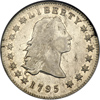 |
1795. BB-27. B-5 R-1. NGC graded AU-53. Mostly untoned with some luster evident, the centers typically weak from insufficient detail in the dies (the outer areas of the coin are sharply impressed). BB-27 is the most easily recognized 1795 flowing hair variety. Liberty has flowing hair in six curls, the 3rd and 4th close together; at the 4th curl there is a tiny curved "tail" extending downward, and visible on higher grade pieces. Lowest curl distant from star. A diagnostic "bar" over 2 mm. long extends diagonally from close to top curl toward point of 5th star. Look for the "bar" near uppermost curl. (By contrast, BB-20 has a somewhat similar bar much lower, near 4th star.) Wide date, the 1 and 7 farthest apart. First star about as close to 1 as 7 is to 9. Most early die states show striking weakness at the centers. Bowers, in remarking about the often worn impression on the high points of even the best quality pieces, has this to say: "As is the case with the obverse die used to coin BB-21, BB-22, and BB-23, the present obverse had the head of Miss Liberty deeply impressed into the die, causing it to be in slightly higher relief than other varieties of the year; because of this, the hair details wore away quickly as the coins circulated."
Reverse J, as used on BB-27 has three leaves under each wing. 13 berries, seven on left branch, six on right. Three leaves under each wing of eagle. Two berries under first T in STATES, one on inside and one on outside of wreath.
Estimated Value $15,000 - 18,000.
View details and enlarged photos
| Unsold |
Lot 3011 |
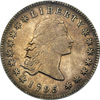 |
1795. 2 leaves beneath each wing. BB-21; B-1 R-2. NGC graded EF-45. Light even toning in shades of medium gray to medium brown, deepest at the rims. Lack of detail in the hair is almost diagnostic of BB-21 (and BB-27) since the head of Liberty was punched deeply into the die, resulting in quick wear once the coin got into circulation. This variety has a small raised "bar" just to the right of the 4th star and is not to be confused with BB-27 which has a longer raised bar close to the top curl. Not scarce, but therefore ideal for a Type set since it carries no extra rarity premium. Pop 4; 8 finer for the variety at NGC.
Estimated Value $10,000 - 12,000.
View details and enlarged photos
| Realized
$12,075 |
Lot 3012 |
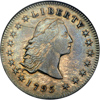 |
1795. 3 leaves beneath each wing. BB-27; B-5 R1. NGC graded EF-45. Nice even light blue and grey toning with a faint hairline scratch (or is it an adjustment line?) across the face from the nose to the hair. There are a few planchet streaks behind the head, but the color is well balanced, all original, making this BB-27 coin a highly presentable one. Generally sharply made except at Liberty's hair and on the eagle's breast; also there is minor lack of detail in the right wing feathers (as the viewer sees it), but this is more than made up for by the beautiful surface condition and attractive toning. It seems redundant to say this: since the 1794 flowing hair dollar is so expensive and usually found in such miserable conditioin, that leaves the 1795 as the coin to choose when picking a date to represent this type. Pop 9; 17 finer for the variety at NGC.
Estimated Value $9,000 - 11,000.
View details and enlarged photos
| Unsold |
Lot 3013 |
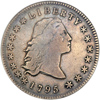 |
1795. 3 leaves beneath each wing. BB-27, B-5. ANACS graded VF-20. Light grey toning on both sides. Popular first design US Dollar. A fairly choice coin with almost no surface abrasions, although a mild and inoffensive edge "flaw" (most likely part of the cut-out from the silver strip from which the blank was made) may be seen at the 4 o'clock position on reverse (almost hidden by the slab insert), and a tiny annealing flaw appears between the "C" and "A" of AMERICA. All in all, a very pleasing and presentable example of the first design-type of U.S. silver dollar (PCGS # 6852) .
Estimated Value $4,000 - 4,500.
View details and enlarged photos
Check results on similar lots
| Realized
$4,830 |
Lot 3014 |
 |
1795. Silver plug. BB-21; B1 R2. PCGS graded VF-25. Dark grey toning on both sides. Nice details for the grade, although there are a few marks in the fields, in above L in LIBERTY, a few at the neck, another abbove star 2, etc. But all in all the coin fits nicely within this grade classification, and has excellent, problem-free rims. The unusual "silver plug" is readily apparent on the reverse at center. The silver plug coins are known on several dates and varieties, but usually on just a few coins of each. It is believed that during the planchet making process, now and then planchets would be underweight (each was weighed by hand), and would normally have to be remelted, drawn and cut to size again. Possibly using the silver center cent as an example, it was decided to drill out the center of the blank silver dollar planchet on these underweight pieces, insert a silver "plug" so as to bring the weight up to the required 26.96 gram standard, and strike the coin normally. The plug would flatten out and become meshed with the coin, increasing the weight to the required tolerance (PCGS # 6854) .
Estimated Value $5,000 - 6,000.
View details and enlarged photos
Check results on similar lots
| Realized
$14,950 |
|
|